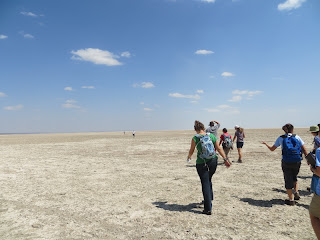Today, I played with poop. Our wildlife ecology lessons
started with our Professor plopping dried animal poop on our desks and ended
with us identifying poop in the field with the help of Maasai guides. I can
pretty much see all you non-biologist types cringing with disgust, but trust
me, it was actually a lot of fun. We sampled quadrants from the salt flats around
Lake Manyara to the grasslands surrounding Lake Manyara National park and noted
the type of animal dung we found. The Maasai guides were extremely
knowledgeable and could identify animal species extremely fast from the type of
droppings left behind. Oh and yeah, we just casually hung out with the Maasai. It was pretty awesome. Most exciting part of the exercise besides interacting with the Maasai?: probably finding a dung maiden (aka a poop pile).
The geologist in me was also super ecstatic about today’s
events because we got to run around the salt flats surrounding Lake Manyara. I
don’t think I have ever walked on something so crunchy and squishy at the same
time, and I FREAKING LOVED IT. Underneath the salt (which is evaporated from
the seasonally changing lake) was a ton of red algae and other organic matter
mixed with mud. Every time you took a step your boots sunk further and further
into the strange mixture. The smell was horrible, but I could have spent all
day running around the out-of-this-world landscape. Unfortunately, this is not a
geology trip so no one shares my enthusiasm for the rocks. I did, however; find
a beautiful volcanic rock with some pretty awesome crystals while frolicking around
the dung piles, so it totally made up for lack of time spent in the salt flats.
The salt flats around Lake Manyara- searching for the lake
What we found instead of the lake- decaying organic matter + muddy mixture underneath the crunchy salt
In other news:
Yesterday was our first non-program scheduled day, and we
got to travel to Elephant Cave and the town of Karatu. Elephant Cave is not a
real cave in any definition; it is made not by the reaction of water with
rocks, but by elephants. Because elephant are herbivores, their diets tend to
lack in minerals such as iron and so they need to get them from somewhere else.
Much of the landscape around Ngorongoro Crater (and Lake Manyara which I
mentioned in my last post) has a volcanic history either sourcing back to lava
flows or ash falls. Volcanic eruptions release tons of heavy metals/minerals,
and the soils they are incorporated into become good sources for necessary
minerals. Since the elephants are not getting these minerals from the plants
they are eating, they have learned to supplement their diets by digging out and
eating soil. To get to Elephant Cave we hiked through the tropical landscape
near Ngorongoro Crater, and we got to learn about some of the plants in the
areas. We also got to see a pretty cool waterfall on our hike back.
Elephant Cave
Karatu is a small service town very near to our camp in Rhotia. We got to walk around the market and bargain a bit after our trip to Elephant Cave. I got some pretty awesome fabric so that I can have a local tailor make me some cool pants, a skirt, and probably some headbands. You'll have to contain your excitement; I'm sure you're dying to see me in some African-made garb, but it will take some time to get them made. After our trip to the market, we spent a couple hours in a small pub called Happy Days and got to relax with a couple beers. We aren't allowed to drink much on this trip (no alcohol in camp, pretty much no alcohol outside of camp, and when we are allowed it's about a max of two beers), but it was nice to be able to have one and enjoy the day.
Until next time...




Elephants are really freaking weird.
ReplyDelete